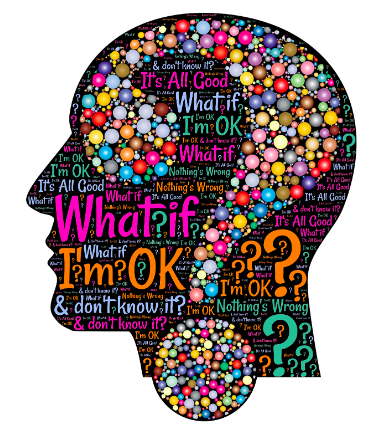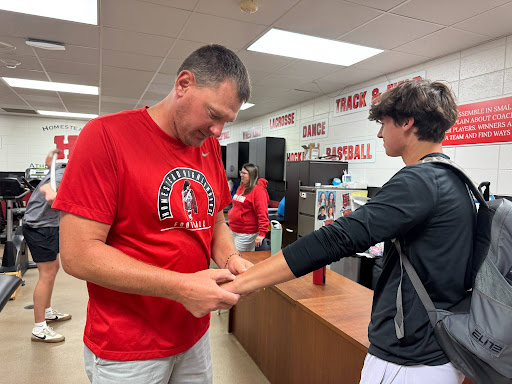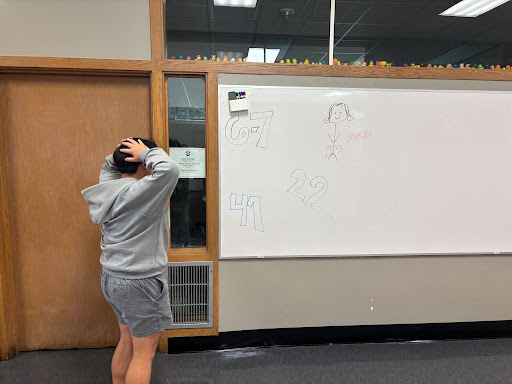A closer look at the rise in anxiety

This image represents the array of thoughts those affected by anxiety experience.
“I started to feel overwhelmed, and dozens of things were soaring through my head. Negative thoughts clouded my brain, telling me all the possible ways things could go wrong. I started to feel short of breath and dizzy, so I asked to go to the office. When I got there, I immediately passed out, and when I woke up I realized that I had just experienced my first panic attack – of that day.”
These are the words of an anonymous sophomore student describing one of her panic attacks, a common symptom of anxiety.
Anxiety, according to the Anxiety and Depression Association of America, is the most common mental illness today, rising among teens. The feeling of worry, nervousness, or unease, typically about an impending event or something with an uncertain outcome, is how anxiety victims would describe it. Although anxiety has been a persistent problem for people of any age, over the past decade, a huge surge of students have developed anxiety.
According to Terry Carr, Homestead’s social worker, anxiety is hard to diagnose because the symptoms are also shared with ADHD and depression. However, ADHD and anxiety often go hand in hand, which is why they’re so often misdiagnosed. The National Comorbidity Survey Replication reported that 47 percent of adults with ADHD had an anxiety disorder of some kind.
According to Carr, anxiety in Mequon’s students can be seen even more than in other cities because of the communities high standards. “These kids live in a community where there’s a lot of pressure… and the kids put even more pressure on themselves,” Carr said.
However, according to Carr, “genetics load the gun and the environment pulls the trigger,” meaning that most students with anxiety have manifested anxiety since birth; however, circumstances can make it better or worse.
These circumstances can be anything, but according to Carr, and four Homestead students interviewed with anxiety, there are multiple main factors. The largest factor being school. For many students with anxiety, school can provide a source of dread and be very overwhelming.“I think school and social pressure/expectations worsens my anxiety a lot,” an anonymous sophomore said.
For some students, leaving the safety of their home to come to school is nearly impossible. “For a while it was hard to stay in school, and I kinda just wanted to be at home in my bed where I didn’t have to worry about anything,” another anonymous student, a senior, said.
For others, keeping up with classes and grades was difficult. “I overthink everything and doing even one homework assignment will take me hours, or until I just give up because I can’t take it anymore,” an anonymous senior, said.
Still, even with all the added stress from school, it’s not the only culprit triggering anxiety in teens. “Social media can increase anxiety and there has been a lot of research on that. There’s been an increase [in anxiety] since 2011, which was right around when many kids got their first smartphones,” Carr said.
Out of the four students interviewed, all agreed unanimously that social media took part in their anxiety. “I deleted Instagram because I felt like I was trying to live up to somebody I’m not,” an anonymous senior student said. They all stated that social media opens them up to unrealistic standards that lower their self esteem and cause them more anxiety.
Social media has only grown more popular since many different platforms have released. With Snapchat, Facebook, Instagram and VSCO, teens everywhere are constantly connected, which can be detrimental to many. “I think that people don’t hold back as much online, and social media allows them to connect with friends and say whatever they want with little to no consequences,” an anonymous senior, said.
Many educators at Homestead also believe there are a couple main factors to anxiety. “Anxiety is high in today’s society because of a culmination of diet, sleep deprivation, social media and intense academic setting,” Kelly Denk, English teacher, said. According to Denk, anxiety in students it through the roof and can be caused even by an imbalanced diet.
With the increase in anxiety, teens, parents and educators everywhere are left questioning what they can do to cope. People affected by anxiety often times seek professional help to ease their struggles. “We have students that come [to the counseling office], but we have many students that seek outside support, which I’m glad for. I think people are recognizing [anxiety] more, it’s not something to be ashamed of,” Carr said.
Out of the four students interviewed, all seek professional help through therapy. “Therapy helps me validate my feelings while learning how to cope with them. It’s really helpful,” anonymous sophomore said.
Other popular coping mechanisms include listening to music, journalling, physical activity or drawing. “A positive mindset is the most important coping mechanism I’ve been taught. Just remembering that this feeling is temporary is the most important part,” an anonymous junior said.
Some students take their anxiety into their own hands. “I think students need to pay more attention to self care. They need to prioritize what they’re eating, how much they’re sleeping and how much time they spend online,” Denk said.
Although anxiety can be a difficult disease to struggle with, it’s victims cleary can persevere with the right tools.

Claudia Chedid is a Junior at Homestead High School. She is involved in the Kids 4 Kids club, as well as the student council. When not at school, Claudia...





